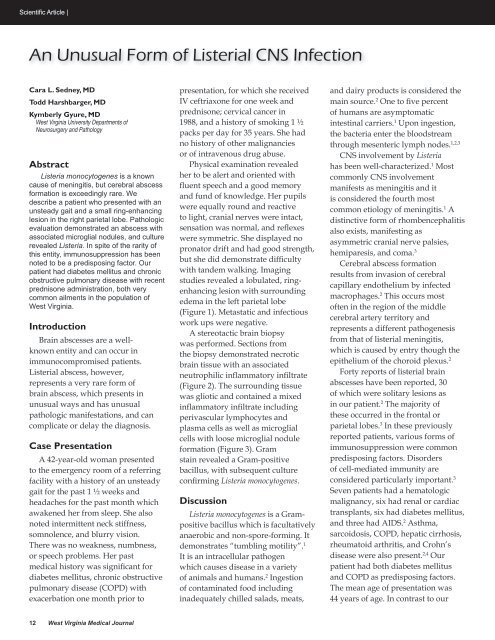Adam E. Klein, MD - West Virginia State Medical Association
Adam E. Klein, MD - West Virginia State Medical Association
Adam E. Klein, MD - West Virginia State Medical Association
You also want an ePaper? Increase the reach of your titles
YUMPU automatically turns print PDFs into web optimized ePapers that Google loves.
Scientific Article |An Unusual Form of Listerial CNS InfectionCara L. Sedney, <strong>MD</strong>Todd Harshbarger, <strong>MD</strong>Kymberly Gyure, <strong>MD</strong><strong>West</strong> <strong>Virginia</strong> University Departments ofNeurosurgery and PathologyAbstractListeria monocytogenes is a knowncause of meningitis, but cerebral abscessformation is exceedingly rare. Wedescribe a patient who presented with anunsteady gait and a small ring-enhancinglesion in the right parietal lobe. Pathologicevaluation demonstrated an abscess withassociated microglial nodules, and culturerevealed Listeria. In spite of the rarity ofthis entity, immunosuppression has beennoted to be a predisposing factor. Ourpatient had diabetes mellitus and chronicobstructive pulmonary disease with recentprednisone administration, both verycommon ailments in the population of<strong>West</strong> <strong>Virginia</strong>.IntroductionBrain abscesses are a wellknownentity and can occur inimmunocompromised patients.Listerial abscess, however,represents a very rare form ofbrain abscess, which presents inunusual ways and has unusualpathologic manifestations, and cancomplicate or delay the diagnosis.Case PresentationA 42-year-old woman presentedto the emergency room of a referringfacility with a history of an unsteadygait for the past 1 ½ weeks andheadaches for the past month whichawakened her from sleep. She alsonoted intermittent neck stiffness,somnolence, and blurry vision.There was no weakness, numbness,or speech problems. Her pastmedical history was significant fordiabetes mellitus, chronic obstructivepulmonary disease (COPD) withexacerbation one month prior topresentation, for which she receivedIV ceftriaxone for one week andprednisone; cervical cancer in1988, and a history of smoking 1 ½packs per day for 35 years. She hadno history of other malignanciesor of intravenous drug abuse.Physical examination revealedher to be alert and oriented withfluent speech and a good memoryand fund of knowledge. Her pupilswere equally round and reactiveto light, cranial nerves were intact,sensation was normal, and reflexeswere symmetric. She displayed nopronator drift and had good strength,but she did demonstrate difficultywith tandem walking. Imagingstudies revealed a lobulated, ringenhancinglesion with surroundingedema in the left parietal lobe(Figure 1). Metastatic and infectiouswork ups were negative.A stereotactic brain biopsywas performed. Sections fromthe biopsy demonstrated necroticbrain tissue with an associatedneutrophilic inflammatory infiltrate(Figure 2). The surrounding tissuewas gliotic and contained a mixedinflammatory infiltrate includingperivascular lymphocytes andplasma cells as well as microglialcells with loose microglial noduleformation (Figure 3). Gramstain revealed a Gram-positivebacillus, with subsequent cultureconfirming Listeria monocytogenes.DiscussionListeria monocytogenes is a Grampositivebacillus which is facultativelyanaerobic and non-spore-forming. Itdemonstrates “tumbling motility”. 1It is an intracellular pathogenwhich causes disease in a varietyof animals and humans. 2 Ingestionof contaminated food includinginadequately chilled salads, meats,and dairy products is considered themain source. 2 One to five percentof humans are asymptomaticintestinal carriers. 1 Upon ingestion,the bacteria enter the bloodstreamthrough mesenteric lymph nodes. 1,2,3CNS involvement by Listeriahas been well-characterized. 1 Mostcommonly CNS involvementmanifests as meningitis and itis considered the fourth mostcommon etiology of meningitis. 1 Adistinctive form of rhombencephalitisalso exists, manifesting asasymmetric cranial nerve palsies,hemiparesis, and coma. 3Cerebral abscess formationresults from invasion of cerebralcapillary endothelium by infectedmacrophages. 2 This occurs mostoften in the region of the middlecerebral artery territory andrepresents a different pathogenesisfrom that of listerial meningitis,which is caused by entry though theepithelium of the choroid plexus. 2Forty reports of listerial brainabscesses have been reported, 30of which were solitary lesions asin our patient. 2 The majority ofthese occurred in the frontal orparietal lobes. 3 In these previouslyreported patients, various forms ofimmunosuppression were commonpredisposing factors. Disordersof cell-mediated immunity areconsidered particularly important. 3Seven patients had a hematologicmalignancy, six had renal or cardiactransplants, six had diabetes mellitus,and three had AIDS. 2 Asthma,sarcoidosis, COPD, hepatic cirrhosis,rheumatoid arthritis, and Crohn’sdisease were also present. 2,4 Ourpatient had both diabetes mellitusand COPD as predisposing factors.The mean age of presentation was44 years of age. In contrast to our12 <strong>West</strong> <strong>Virginia</strong> <strong>Medical</strong> Journal















